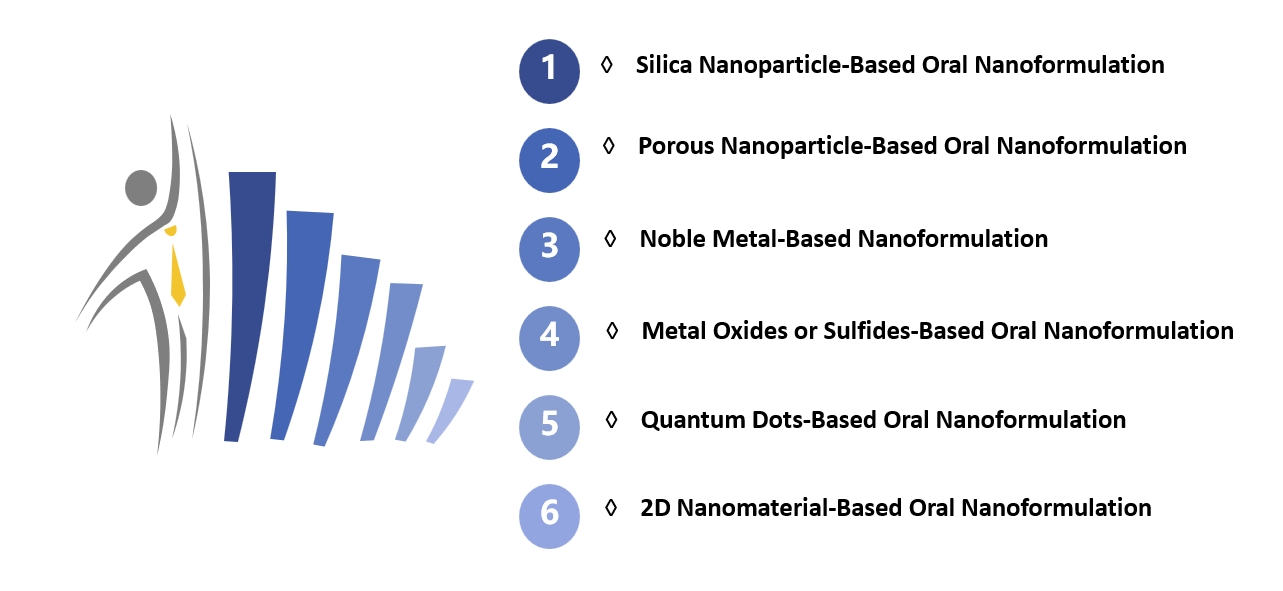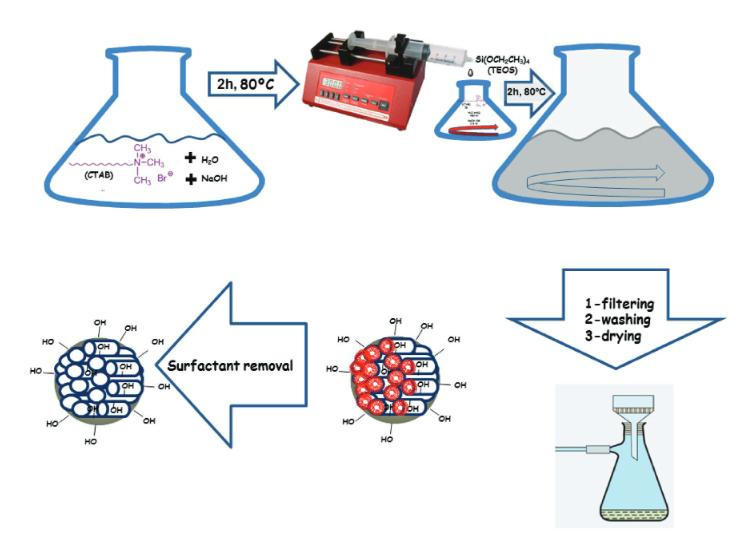Oral Nanoformulation Development based on Inorganic Nanomaterials
Inquiry
Inorganic nanomaterials, as oral delivery carriers, have various advantages such as biodegradability, biocompatibility, non-immunogenicity, extended delivery, and easy modification, and have been widely used in multiple oral nanoformulations. CD Formulation can provide you with formulation development services for inorganic nanomaterial-based oral nanoformulation to meet your different requirements.
Our Services for Inorganic Nanomaterial-Based Oral Nanoformulation Development
Inorganic nanomaterials produced from non-metallic and metallic systems have unique advantages in terms of physicochemical properties and performance, such as mild synthesis processes and more controllable size, morphology, and surface functionalization of inorganic nanomaterials. Therefore, Inorganic nanomaterial-based nanoformulation has considerable potential as oral medicine. CD Formulation, as a leading pharmaceutical laboratory services company, can provide you with the following various nanoformulation development.
 Fig.1 Six types of inorganic nanomaterial-based oral nanoformulation. (CD Formulation)
Fig.1 Six types of inorganic nanomaterial-based oral nanoformulation. (CD Formulation)
Our Strategies for Novel Inorganic Nanomaterial Carrier Development
Novel inorganic nanoformulations mainly include quantum dots, nanogold materials, carbon nanomaterials, mesoporous silica nanoparticles, magnetic nanomaterials, nanocalcium materials, etc. We utilize an advanced design approach to employ various preparation techniques tailored to the unique properties of novel inorganic nanomaterial-based oral nanoformulations. This ensures the creation of inorganic nanocarriers that align with your specific needs. Our solutions for inorganic nanomaterial-based oral nanoformulations are as follows regarding different inorganic nanomaterials.
Quantum Dots
Quantum dots (QD) are nanoparticles composed of II-VI or III-V elements, such as sulfide (ZnS, CuS, PbS, CdS), selenide, telluride, carbon (silicon), etc. Its diameter is about 2-10 nm. Our design strategy is precise modification of target surface and innovation of material structure. Precise modification of the target surface can promote the enrichment of quantum dots at the tumor site, thereby leveraging the fluorescence, photodynamic, and photothermal advantages of quantum dots.
Mesoporous Silica Nanoparticles
Nanometre mesoporous silica has a specific pore structure, is hollow, has a low density and a large specific surface area, and exhibits unique permeability, molecular sieving ability, optical properties, and adsorption properties. We are committed to research the synthesis, modification, and characterization of mesoporous silica nanoparticles, and we can also provide the following characterization services, including textural properties (pore diameter, surface area, and pore volume), various mesostructures (disordered, wormhole-like, hexagonal, cubic, and lamellar mesophases), and morphology (spheres, hollow spheres, nanofibers, nanotubules, etc.).
Carbon Nanomaterials
Carbon nanomaterials are carbon materials dispersed in at least one dimension < 100 nm, including carbon nanoparticles, graphene, carbon nanotubes, fullerenes, diamonds, and other various carbon-based hybrid nanostructures. We can provide you with the preparation of carbon nanomaterials based on your special needs.
Nanogold Materials
Nanogold materials are gold nanoparticles synthesized from different matrices under different reaction conditions, with sizes ranging from 1-100 nm. We can synthesize the following gold nanomaterials according to customer requirements, including gold nanospheres, nanorods, gold nanostars and gold nanocages, etc. At the same time, to improve the superior performance of nan-gold as a nanoformulation carrier, our team also explored nanogold surface modification methods to meet the requirements of different customers.
Magnetic Nanomaterials
Magnetic nanomaterials mainly include Fe3O4 and perovskite compounds. With years of research experience, we are committed to research on preparation methods of magnetic nanomaterials. One of our most successful studies is the preparation of single-core Fe3O4/SiO2 core/shell nanoparticles by the inverse microemulsion method.
Nanocalcium Materials
Nanocalcium is mainly a bionic nanomaterial designed based on the human bone structure, including hydroxyapatite, CaCO3, CaO, etc. We offer design and customization services for nanoclacium materials to meet your different requirements.
Our Analytical Capabilities for Inorganic Nanomaterial-Based Oral Nanoformulation
The function and fate of inorganic nanoparticles in GIT depend on their physicochemical properties such as shape, size, composition, porosity, and surface chemistry. We can provide the following characterization of inorganic nanomaterial-based oral nanoformulation including:
- Particle Size
- Zeta Potential
- Morphology
- Drug Loading
- In Vitro Drug Release
- Stability
Why Choose Us to Develop Inorganic Nanomaterial-Based Oral Nanoformulations?
- We have long been committed to innovative research on oral nanoformulations based on inorganic nanomaterials. At present, gratifying results have been achieved in the development of oral nanoformulations based on quantum dots, carbon nanomaterials, gold nanomaterials, magnetic nanomaterials, and mesoporous silica nanomaterials, etc.
- We have advanced rapid nanomedicine preparation systems and other equipment, as well as a strong elite team that can provide you with end-to-end professional services for inorganic nanomaterial-based oral nanoformulations.
- We can also respond immediately and quickly to your needs for analysis and characterization services for inorganic nanomaterial-based oral nanoformulation including particle size, zeta potential, morphology, drug loading, in vitro release, and stability.
Published Data
Technology: The sol - gel method for production of MSNs
Journal: Advanced Functional Materials
IF: 19.0
Published: 2020
Results:
The authors review recent advances in the synthesis of mesoporous silica nanoparticles (MSNs) and their use as nanocarriers for drug delivery. and discusses recent trends in such nanoparticles and their use in modern medicine. Additionally, the authors describe a synthetic route for MSN synthesis in which surfactant molecules are initially dissolved in water and then silica precursors are added dropwise, which condense around the surfactant template. Then, after the sol–gel process occurs and silica nanoparticles are formed, surfactant removal results in monodisperse spherical MSNs. Here is the illustration of synthetic path for the synthesis of MSNs.
 Fig.2 Synthetic path for the synthesis of MSNs. (Miguel Manzano, et al. 2020)
Fig.2 Synthetic path for the synthesis of MSNs. (Miguel Manzano, et al. 2020)
Based on our advanced rapid nanomedicince preparation system, CD Formulation has always been at the forefront of developing inorganic nanomaterial-based oral nanoformulations. If you have any questions about the development and quality research of oral nanoformulation based on inorganic nanomaterials, please contact us anytime and anywhere for in-depth communication.
References
- Miguel Manzano, María Vallet-Regí. Mesoporous Silica Nanoparticles for Drug Delivery. Advanced Functional Materials. 2020, 30, 1902634.
How It Works
STEP 2
We'll email you to provide your quote and confirm order details if applicable.
STEP 3
Execute the project with real-time communication, and deliver the final report promptly.
Related Services

 Fig.1 Six types of inorganic nanomaterial-based oral nanoformulation. (CD Formulation)
Fig.1 Six types of inorganic nanomaterial-based oral nanoformulation. (CD Formulation) Fig.2 Synthetic path for the synthesis of MSNs. (Miguel Manzano, et al. 2020)
Fig.2 Synthetic path for the synthesis of MSNs. (Miguel Manzano, et al. 2020)
